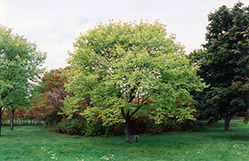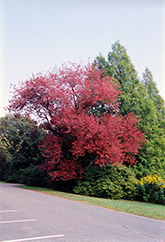Schlesinger Red Maple
Acer rubrum 'Schlesingeri'
Height: 60 feet
Spread: 50 feet
Sunlight:
![]()
Hardiness Zone: 4
Other Names: Swamp Maple, Scarlet Maple
Description:
Without a doubt one of the earliest of all trees for fall color, turning a rich, deep reddish-purple color which holds for a long time; a large upright and rounded, somewhat irregular form; intolerant of alkaline soils
Ornamental Features
Schlesinger Red Maple features showy clusters of red flowers along the branches in early spring before the leaves. It has dark green deciduous foliage which emerges red in spring. The lobed leaves turn an outstanding burgundy in the fall. It produces red samaras in late spring. The furrowed silver bark and brick red branches add an interesting dimension to the landscape.
Landscape Attributes
Schlesinger Red Maple is a deciduous tree with a more or less rounded form. Its average texture blends into the landscape, but can be balanced by one or two finer or coarser trees or shrubs for an effective composition.
This is a relatively low maintenance tree, and should only be pruned in summer after the leaves have fully developed, as it may 'bleed' sap if pruned in late winter or early spring. It has no significant negative characteristics.
Schlesinger Red Maple is recommended for the following landscape applications;
- Accent
- Shade
Planting & Growing
Schlesinger Red Maple will grow to be about 60 feet tall at maturity, with a spread of 50 feet. It has a high canopy of foliage that sits well above the ground, and should not be planted underneath power lines. As it matures, the lower branches of this tree can be strategically removed to create a high enough canopy to support unobstructed human traffic underneath. It grows at a medium rate, and under ideal conditions can be expected to live for 90 years or more.
This tree should only be grown in full sunlight. It is quite adaptable, prefering to grow in average to wet conditions, and will even tolerate some standing water. It is not particular as to soil type, but has a definite preference for acidic soils, and is subject to chlorosis (yellowing) of the foliage in alkaline soils. It is somewhat tolerant of urban pollution. This is a selection of a native North American species.

